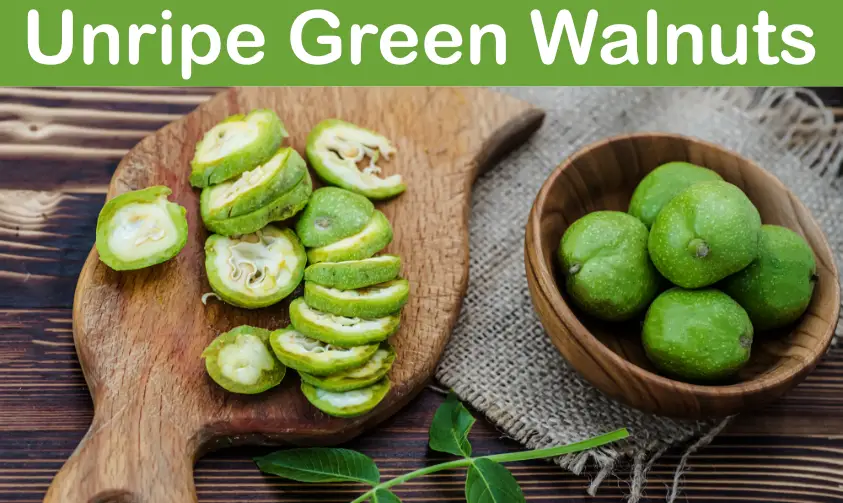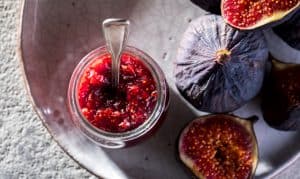The term “unripe” typically means that the fruit has not yet ripened, so it is green and firm to the touch. The term “ripe” refers to a fully developed walnut that has turned brown or dark in color.
Unripe walnuts have around sleek nut shape with a green, tight outer skin. Ripe walnuts have an elongated, pointy shape with a dark brown shell that is slightly loose from the nutmeat.
In both cases, walnut flesh is cream-colored with an oily texture. The unique flavor of fresh raw walnut is typically described as rich or buttery and this flavor can vary depending on the variety of tree it was grown on.

How to identify unripe walnuts?
Walnuts transform from the green shell to a much darker brown one when they’re in their fruiting stage.
This process, which goes on inside the shell, can take anywhere from 1 to 3 years before it happens, and it all depends on how long they were growing since their last frost.
When they’re finally ready, the nuts will drop onto the ground where you’ll need to rake them up.
To help identify unripe walnuts, it is important to keep in mind how they look and smell. Unripe walnuts are green, they smell musty or like moist earth, and the outer husks of the nut are tough to break through with a thumbnail or fingernail. The size should be much smaller than that of a ripe walnut as well.
As a rule of thumb, walnuts that are picked green, or unshelled, will stay green for quite some time. They have to mature on the tree before it’s safe to harvest them and transport them to market.
Green walnuts can be stored in the fridge for up to 3 months but shouldn’t be frozen.
How do you know when black walnuts are ripe?
Black walnuts are usually ready to harvest by the end of October or the beginning of November. They can be identified as ripe because they will fall from the tree once ripe. They will not turn brown. A fully ripe black walnut has a flat side and a roughly round top (see figures).
The husk can be easily removed from the nut. In addition, when gripped, it feels lighter than a green walnut: This is because the kernel is larger than that of green walnut.
Can you eat unripe walnuts?
Although the green outer shells of unripe walnuts are sometimes used to flavor foods, they are inedible until fully ripened.
If you have a lot of unripe walnuts, you can use them to prepare nocino. Nocino is a walnut liqueur, popular in Italy, that is made with black walnuts.
Here are the steps to prepare nocino:
- Cut the unripe walnuts into halves.
- Place the cut walnuts into a large glass jar with a tight lid.
- Add white wine and sugar to the jar, cover and shake well for about two minutes or until sugar dissolves and liquid turns clear. You can add additional spices if you wish to add them: nutmeg, cinnamon, cloves and cardamom are good choices for this.
- Let the mixture stand in a warm place for at least as long as Christmas, usually from three to six months.
- Filter the nocino through a fine sieve, dilute it with water if needed, and you are ready to enjoy it!
Enjoy the deliciously sweet and strong nocino after dinner with some cheese or as an after-dinner drink.
You can also use it in baking, on ice cream, or just for a refreshing drink! When preparing nocino, you should remember that the best results are achieved with the highest quality walnuts.
You should use only firm, green walnuts for making the liqueur and discard any that are soft or moldy.
Are green walnuts poisonous?
Walnuts are from a family of plants that includes poison ivy and sumac. If you’re allergic to these plants, they may cause a skin condition such as hives or hay fever.
However, in general, green walnuts are not poisonous. Some people might find them mildly irritating to the mouth and stomach. Eating more than a handful is generally considered unhealthy, but will not cause any major issues.
Green walnuts, which are immature versions of their ripe counterparts, are green because they haven’t yet had a chance to finish maturing on the branch and turn brown.
As mentioned above, they are commonly used to make nocino, an Italian liqueur.
So, you are eating green walnuts if you do not have any allergies related to nuts or ivy plants.
Note: Similarly, unripe black walnuts are also not poisonous similar to any other green walnuts.
Can you pickle green walnuts?
Green unripe walnuts can be pickled, but it may not be an easy task. They will require a higher vinegar solution (mix of white and apple cider vinegar) than what is typically used for pickling.
The fruit must also be pared and quartered before being submerged in the vinegar mixture for 6-8 weeks in refrigerator temperatures.
Instructions:
- In a heavy saucepan, combine ¾ cup each of white and apple cider vinegar with ½ cup sugar or less if preferred
- Peel green walnuts, then cut each one into 4-6 slices (or cut down the middle if they are rounded).
- Place slices into a large bowl with lemon juice to keep them from darkening.
- Place the walnuts into a glass or plastic container.
- Pour vinegar and sugar mixture into the container.
- Cover the top tightly and let sit in the refrigerator for 6-8 weeks, stirring once or twice per week. (If you prefer quick pickles, simply discard the mixture after 2 weeks and start over.) The walnuts should be firm in texture at this point;
- Remove from vinegar mixture and drain on paper towels to remove excess vinegar before serving. Remember that they will continue pickling in the ‘brine’ throughout storage, so plan accordingly when making these as a gift item.
Additional notes:
- If you are using an actual ‘pickling’ vinegar (available in the spice isle at most grocery stores), consider mixing it with the white and apple cider vinegar for a sweeter pickle.
- Remember to wear rubber gloves when handling green walnuts, as they can irritate the skin.
- Green walnuts pickled in a glass or plastic container may look like they are going to float, but rest assured that they will not if they are immersed properly.
- You can also make a quick pickle of green walnuts by using the above procedure, then storing them in the refrigerator for a few weeks.
- The vinegar solution can be reused as long as it is fresh and has not been contaminated by debris, etc.
What is the best way to store unripe walnuts?
Many of us enjoy the taste of walnuts but are often disappointed when they are not yet ready to eat. Unripe walnuts should be stored in a cool dry place until they ripen and deepen in brown color.
Here are some storage ideas to help your green nuts become tasty treats!
Walnuts should be stored in a paper bag or container with holes to allow good air circulation. This will prevent the buildup of moisture and keep them from drying out too quickly.
Place the container or bag on a shelf in an area where it can get plenty of exposure to light while still being shaded from direct sunlight or other sources that could potentially cause overheating.
If you have walnuts that are not yet ready to eat but you cannot use them right away, place them in the freezer.
Ideally, this should be done while the nuts are still green; however, it can be successfully accomplished even after they have started to turn brown.
Freezing is a great way to prolong the life of your walnuts because it can extend the length of time that they will properly ripen and remain fresh.
This method of preservation is also a great way to keep them fresh and available whenever you need them.
Just be sure that they will be able to be thawed quickly when you are ready to use them.
Note: Green walnuts should always be stored in an area away from direct sunlight in order to help them remain moist and stay fresh for longer durations.


